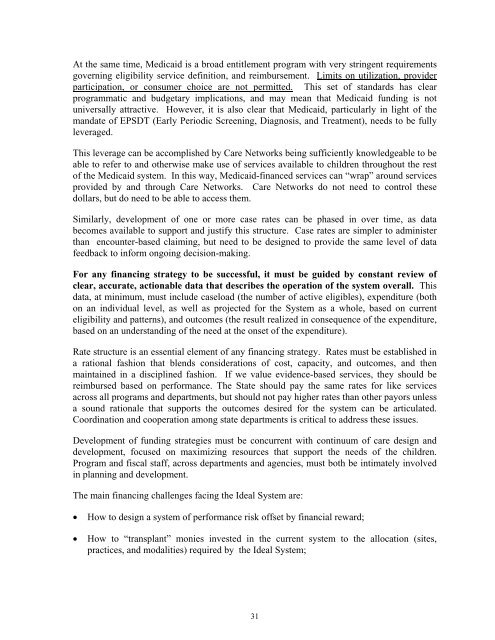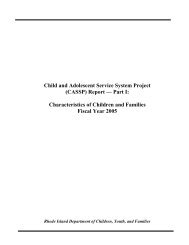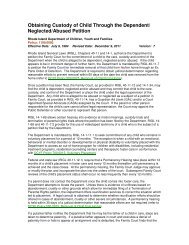system of care for rhode island's children, youth and families
system of care for rhode island's children, youth and families
system of care for rhode island's children, youth and families
Create successful ePaper yourself
Turn your PDF publications into a flip-book with our unique Google optimized e-Paper software.
At the same time, Medicaid is a broad entitlement program with very stringent requirements<br />
governing eligibility service definition, <strong>and</strong> reimbursement. Limits on utilization, provider<br />
participation, or consumer choice are not permitted. This set <strong>of</strong> st<strong>and</strong>ards has clear<br />
programmatic <strong>and</strong> budgetary implications, <strong>and</strong> may mean that Medicaid funding is not<br />
universally attractive. However, it is also clear that Medicaid, particularly in light <strong>of</strong> the<br />
m<strong>and</strong>ate <strong>of</strong> EPSDT (Early Periodic Screening, Diagnosis, <strong>and</strong> Treatment), needs to be fully<br />
leveraged.<br />
This leverage can be accomplished by Care Networks being sufficiently knowledgeable to be<br />
able to refer to <strong>and</strong> otherwise make use <strong>of</strong> services available to <strong>children</strong> throughout the rest<br />
<strong>of</strong> the Medicaid <strong>system</strong>. In this way, Medicaid-financed services can “wrap” around services<br />
provided by <strong>and</strong> through Care Networks. Care Networks do not need to control these<br />
dollars, but do need to be able to access them.<br />
Similarly, development <strong>of</strong> one or more case rates can be phased in over time, as data<br />
becomes available to support <strong>and</strong> justify this structure. Case rates are simpler to administer<br />
than encounter-based claiming, but need to be designed to provide the same level <strong>of</strong> data<br />
feedback to in<strong>for</strong>m ongoing decision-making.<br />
For any financing strategy to be successful, it must be guided by constant review <strong>of</strong><br />
clear, accurate, actionable data that describes the operation <strong>of</strong> the <strong>system</strong> overall. This<br />
data, at minimum, must include caseload (the number <strong>of</strong> active eligibles), expenditure (both<br />
on an individual level, as well as projected <strong>for</strong> the System as a whole, based on current<br />
eligibility <strong>and</strong> patterns), <strong>and</strong> outcomes (the result realized in consequence <strong>of</strong> the expenditure,<br />
based on an underst<strong>and</strong>ing <strong>of</strong> the need at the onset <strong>of</strong> the expenditure).<br />
Rate structure is an essential element <strong>of</strong> any financing strategy. Rates must be established in<br />
a rational fashion that blends considerations <strong>of</strong> cost, capacity, <strong>and</strong> outcomes, <strong>and</strong> then<br />
maintained in a disciplined fashion. If we value evidence-based services, they should be<br />
reimbursed based on per<strong>for</strong>mance. The State should pay the same rates <strong>for</strong> like services<br />
across all programs <strong>and</strong> departments, but should not pay higher rates than other payors unless<br />
a sound rationale that supports the outcomes desired <strong>for</strong> the <strong>system</strong> can be articulated.<br />
Coordination <strong>and</strong> cooperation among state departments is critical to address these issues.<br />
Development <strong>of</strong> funding strategies must be concurrent with continuum <strong>of</strong> <strong>care</strong> design <strong>and</strong><br />
development, focused on maximizing resources that support the needs <strong>of</strong> the <strong>children</strong>.<br />
Program <strong>and</strong> fiscal staff, across departments <strong>and</strong> agencies, must both be intimately involved<br />
in planning <strong>and</strong> development.<br />
The main financing challenges facing the Ideal System are:<br />
• How to design a <strong>system</strong> <strong>of</strong> per<strong>for</strong>mance risk <strong>of</strong>fset by financial reward;<br />
• How to “transplant” monies invested in the current <strong>system</strong> to the allocation (sites,<br />
practices, <strong>and</strong> modalities) required by the Ideal System;<br />
31
















